Willkommen, Gast ( Anmelden | Registrierung )
  |
 12. Aug 2011, 14:49 | Beitrag
#61 12. Aug 2011, 14:49 | Beitrag
#61
|
|
|
Oberstleutnant Beiträge: 17.165  Gruppe: VIP Mitglied seit: 02.08.2001 |
Ein Friese ist in der Regel gutmütig und groß, aber das macht ihn noch lange nicht zum Polizeipferd, schonmal auf einem gesessen? Federung ist beim Friesen nicht serienmäßig eingebaut, das ist einfach kein Reitpferd.
-------------------- "Dass Atombomben auf Deutschland gefallen wären, hat eher strategische Gründe und sollte man nicht persönlich nehmen... ."
"Wenn ich groß bin, geh ich zur Volksarmee: Ich lade die Kanone, rumbumm bumm, rumbumm bumm... ." |
|
|
|
 12. Aug 2011, 15:49 | Beitrag
#62 12. Aug 2011, 15:49 | Beitrag
#62
|
|
|
Oberleutnant Beiträge: 2.034  Gruppe: Members Mitglied seit: 09.07.2008 |
Ich habe ja auch nie behauptet das Friesen bequeme Gänge haben.
Aber es kommt dem was ein Polizeipferd ausmacht schon näher. Hier haben die z. B. bunt gemischt Haflinger und Norweger, Stockmaß um die 150cm, klein aber sehr beweglich und mit guter Federung Der Beitrag wurde von Pliskin bearbeitet: 12. Aug 2011, 15:55 |
|
|
|
 12. Aug 2011, 17:49 | Beitrag
#63 12. Aug 2011, 17:49 | Beitrag
#63
|
|
|
Oberstleutnant Beiträge: 11.904 Gruppe: Members Mitglied seit: 03.10.2002 |
So langsam komme ich zu der Überzeugung, daß Elefanten das geeignete "Gerät" sind.
-------------------- Schon seit 20 Jahren: Waffen der Welt
|
|
|
|
 13. Aug 2011, 10:38 | Beitrag
#64 13. Aug 2011, 10:38 | Beitrag
#64
|
|
|
Oberstleutnant Beiträge: 17.165  Gruppe: VIP Mitglied seit: 02.08.2001 |
Ich habe ja auch nie behauptet das Friesen bequeme Gänge haben. Aber es kommt dem was ein Polizeipferd ausmacht schon näher. Hier haben die z. B. bunt gemischt Haflinger und Norweger, Stockmaß um die 150cm, klein aber sehr beweglich und mit guter Federung Wo ist hier? -------------------- "Dass Atombomben auf Deutschland gefallen wären, hat eher strategische Gründe und sollte man nicht persönlich nehmen... ."
"Wenn ich groß bin, geh ich zur Volksarmee: Ich lade die Kanone, rumbumm bumm, rumbumm bumm... ." |
|
|
|
 13. Aug 2011, 13:42 | Beitrag
#65 13. Aug 2011, 13:42 | Beitrag
#65
|
|
|
Oberleutnant Beiträge: 2.034  Gruppe: Members Mitglied seit: 09.07.2008 |
Jo, vergessen
|
|
|
|
 13. Aug 2011, 14:20 | Beitrag
#66 13. Aug 2011, 14:20 | Beitrag
#66
|
|
|
Oberstleutnant Beiträge: 17.165  Gruppe: VIP Mitglied seit: 02.08.2001 |
Jo, vergessen Haflinger klar, aber Norweger -------------------- "Dass Atombomben auf Deutschland gefallen wären, hat eher strategische Gründe und sollte man nicht persönlich nehmen... ."
"Wenn ich groß bin, geh ich zur Volksarmee: Ich lade die Kanone, rumbumm bumm, rumbumm bumm... ." |
|
|
|
 13. Aug 2011, 15:08 | Beitrag
#67 13. Aug 2011, 15:08 | Beitrag
#67
|
|
|
Oberleutnant Beiträge: 2.034  Gruppe: Members Mitglied seit: 09.07.2008 |
Ja, ich müsste mich schon sehr getäuscht haben, denn diese "Bürste" als Mähne haben eigentlich nur Norweger.
|
|
|
|
 13. Aug 2011, 15:13 | Beitrag
#68 13. Aug 2011, 15:13 | Beitrag
#68
|
|
|
Generalmajor d.R. Beiträge: 8.774  Gruppe: Moderator Mitglied seit: 20.10.2004 |
Fjordponys als Polizeipferde? Beeindruckend ist was Anderes, die Viecher sind doch so lieb
-------------------- Liberalmeran.
Der Grad unserer Erregung wächst in umgekehrtem Verhältnis zu unserer Kenntnis der Tatsachen - je weniger wir wissen, desto aufgeregter werden wir. - Bertrand Russell, Eroberung des Glücks |
|
|
|
 13. Aug 2011, 15:26 | Beitrag
#69 13. Aug 2011, 15:26 | Beitrag
#69
|
|
|
Oberleutnant Beiträge: 2.034  Gruppe: Members Mitglied seit: 09.07.2008 |
Denke nicht das die damit was reißen wollen, Präsentz zeigen eher.
Wobei ich mir vorstellen kann das die agiler als Großpferde. Die großen Rassen haben [umgangsprachlich/an] "nen Wendekreis wie nen Panzer [umgangsprachlich/aus] |
|
|
|
 13. Aug 2011, 15:30 | Beitrag
#70 13. Aug 2011, 15:30 | Beitrag
#70
|
|
|
Feldwebel Beiträge: 277 Gruppe: Members Mitglied seit: 23.12.2001 |
Mein Bruder beim Train äusserte die Erfahrung, dass Kaltblüter zwar länger benötigen bis sie ausrasten, aber dann dafür - wenn sie mal durchstarten - schwieriger zu beruhigen seien als Vollblüter. Weiss aber nicht ob das eine allgemeingültige Einschätzung ist.
Was anderes fällt mir beim Polizeipferdebild aber auf: Die Tiere haben keine Gasmaske, das könnte sehr relevant werden, wenn die Lage und Einsatzdoktrin einen Tränengaseinsatz nahelegt. |
|
|
|
 13. Aug 2011, 15:55 | Beitrag
#71 13. Aug 2011, 15:55 | Beitrag
#71
|
|
|
Oberleutnant Beiträge: 2.034  Gruppe: Members Mitglied seit: 09.07.2008 |
Denke das die wenn es erstmal soweit ist das Tränengas eingesetzt wird die Pferde abziehen und gegen die motorisierten Verwandten aka Wasserwerfer tauschen.
|
|
|
|
 10. Dec 2012, 18:35 | Beitrag
#72 10. Dec 2012, 18:35 | Beitrag
#72
|
|
|
Oberleutnant Beiträge: 1.288 Gruppe: Members Mitglied seit: 27.01.2009 |
 ZITAT “Bones,” an Army Special Forces Green Beret, rides his horse on patrol in Northern Afghanistan in 2002. Quelle  ZITAT The president has bestowed the Medal of Honor this afternoon upon the family of Staff Sgt.Robert J. Miller, whose actions allowed seven of his Special Forces teammates and 15 Afghan soldiers to escape an ambush kill zone. Quelle 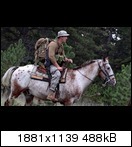 -------------------- ZITAT Aufpassen, dass man nicht mit der Arroganz des eigenen Weltbildes andere aburteilt Goschi Je fester man davon überzeugt ist, im Recht zu sein, desto natürlicher ist der Wunsch, jeden anderen mit allen Mitteln dahin zu bringen, ebenso zu denken. - George Orwell |
|
|
|
 10. Dec 2012, 18:43 | Beitrag
#73 10. Dec 2012, 18:43 | Beitrag
#73
|
|
|
Oberleutnant Beiträge: 1.288 Gruppe: Members Mitglied seit: 27.01.2009 |
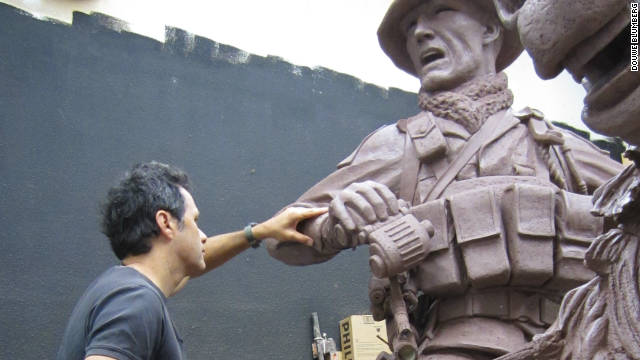 ZITAT Monument honors U.S. 'horse soldiers' who invaded Afghanistan Editor's note: Freelance war correspondent Alex Quade spent nearly 18 months in Iraq and Afghanistan covering U.S. special operations forces on combat missions, including for CNN. Demossville, Kentucky (CNN) -- The U.S. special operations teams that led the American invasion in Afghanistan a decade ago did something that no American military had done since the last century: ride horses into combat. "It was like out of the Old Testament," says Lt. Col. Max Bowers, retired Green Beret, who commanded the three horseback teams. "You expected Cecil B. DeMille to be filming and Charlton Heston to walk out." Bowers spoke while sitting in the rural Kentucky studio of sculptor Douwe Blumberg, along with three of his former "horse soldiers." They, along with 30 fellow commandos on horseback, are the inspiration for a new monument that Blumberg is creating, dedicated to the entire U.S. special operations community. The statue is scheduled to be erected across from the World Trade Center site in New York on November 11, Veterans Day. The artist rounded up these "horse soldiers" to share their personal stories and mission photos as inspiration for the 18-foot, bronze monument. "It was unbelievable in 2001," Master Sgt. Bart Decker says to Blumberg. Decker, the team's Air Force Special Operations combat controller, who is now retired, sports a Fu Manchu-style mustache. "We all looked at each other [and said] 'We're witnessing a cavalry charge!' " he said. Blumberg listens in awe to the elite fighters in his art studio. He says he felt compelled to sculpt the monument after then-Defense Secretary Donald Rumsfeld first held up a photo of these special operations forces on horseback in northern Afghanistan during a 2001 news conference. "The image, I think, typifies the special operations mission of get the job done, however you have to do it, adapt, overcome," the artist tells Bowers and his fellow fighters. That image has also captured the imagination of Hollywood blockbuster producer Jerry Bruckheimer, who's making a movie based on the mission as told by Doug Stanton in his New York Times best-selling book, "Horse Soldiers: The Extraordinary Story of a Band of U.S. Soldiers Who Rode to Victory in Afghanistan." Blumberg learns that the inspirational photo was shot by one of the "killer elite" sitting casually in front of him in his art studio. The horse soldiers' stories "If we wanted to move, horses were the only way," said Master Sgt. Chris Spence, the team's communication sergeant, who serves with 5th Special Forces Group. "Nobody will believe this! (So) I take my camera and (shoot) that photo." Bowers points at that famous photo, explaining to Blumberg: "The Afghans and intelligence officers (CIA) are clotted up in front together, and all our guys are spread out in a wedge behind them." von hier sofrep.com  Es gibt auch ein Buch, das sich mit dieser Thematik beschäftigt: Denverpost -------------------- ZITAT Aufpassen, dass man nicht mit der Arroganz des eigenen Weltbildes andere aburteilt Goschi Je fester man davon überzeugt ist, im Recht zu sein, desto natürlicher ist der Wunsch, jeden anderen mit allen Mitteln dahin zu bringen, ebenso zu denken. - George Orwell |
|
|
|
 11. Dec 2012, 05:58 | Beitrag
#74 11. Dec 2012, 05:58 | Beitrag
#74
|
|
|
Feldwebel Beiträge: 292 Gruppe: Members Mitglied seit: 22.06.2011 |
ZITAT Es gibt auch ein Buch, das sich mit dieser Thematik beschäftigt: Denverpost Das Buch ist sehr empfehlenswert. |
|
|
|
 12. Dec 2012, 21:17 | Beitrag
#75 12. Dec 2012, 21:17 | Beitrag
#75
|
|
|
Oberleutnant Beiträge: 1.288 Gruppe: Members Mitglied seit: 27.01.2009 |
 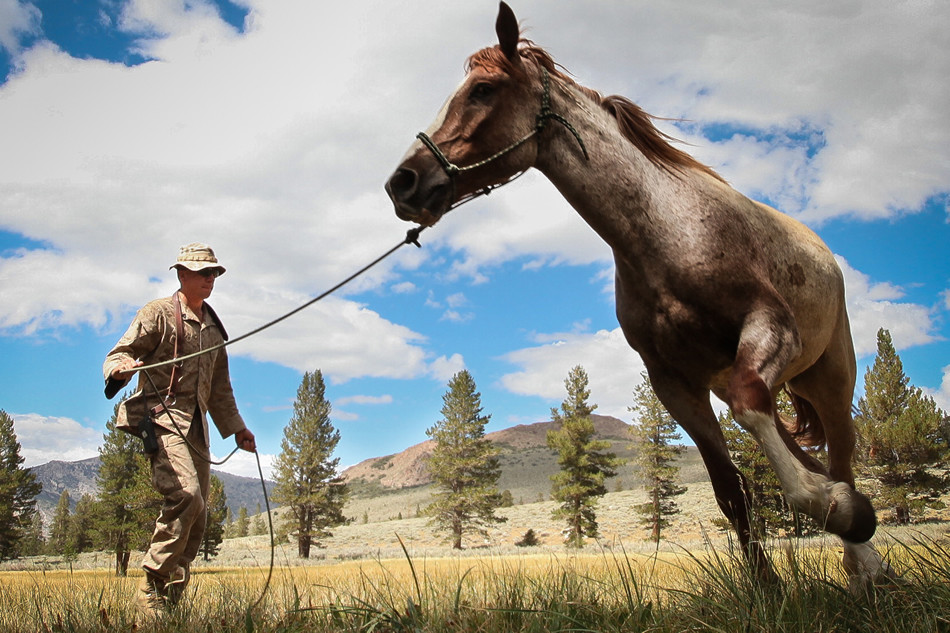 ZITAT Sgt. Justin D. Head, animal packing course chief instructor, excercises his mustang, Hondo, shortly after grazing. The animal packing course is the only one of its kind in the department of defense and teaches Marines and other military personnel how to effectively and efficiently work with beast of burden to transport munitions, supplies and wounded personnel to and from areas inaccessible to mechanized and air transportation. The course, offered at the Marine Corps Mountain Warfare Training Center, teaches an introduction to animal packing, an anatomy of pack animals, animal packing techniques, casualty evacuation techniques, animal first aid and bivouac considerations. Photo by Sgt. Aaron Hostutler 
-------------------- ZITAT Aufpassen, dass man nicht mit der Arroganz des eigenen Weltbildes andere aburteilt Goschi Je fester man davon überzeugt ist, im Recht zu sein, desto natürlicher ist der Wunsch, jeden anderen mit allen Mitteln dahin zu bringen, ebenso zu denken. - George Orwell |
|
|
|
 12. Jan 2013, 01:25 | Beitrag
#76 12. Jan 2013, 01:25 | Beitrag
#76
|
|
|
Oberleutnant Beiträge: 1.288 Gruppe: Members Mitglied seit: 27.01.2009 |
ZITAT U.S. Marines with 3rd Platoon, Delta Company, 1st Reconnaissance Battalion, 1st Marine Division and British Royal Marines start a nine-kilometer packed mule hike at the Mountain Warfare Training Center in Bridgeport, CA, 15 Oct 2007. 
-------------------- ZITAT Aufpassen, dass man nicht mit der Arroganz des eigenen Weltbildes andere aburteilt Goschi Je fester man davon überzeugt ist, im Recht zu sein, desto natürlicher ist der Wunsch, jeden anderen mit allen Mitteln dahin zu bringen, ebenso zu denken. - George Orwell |
|
|
|
 12. Jan 2013, 11:46 | Beitrag
#77 12. Jan 2013, 11:46 | Beitrag
#77
|
|
|
Oberstleutnant Beiträge: 15.459  Gruppe: VIP Mitglied seit: 13.01.2005 |
ZITAT Grey’s Scouts Interview: Michael Watson by Dan Tharp · December 22, 2012 · Posted In: SOF History 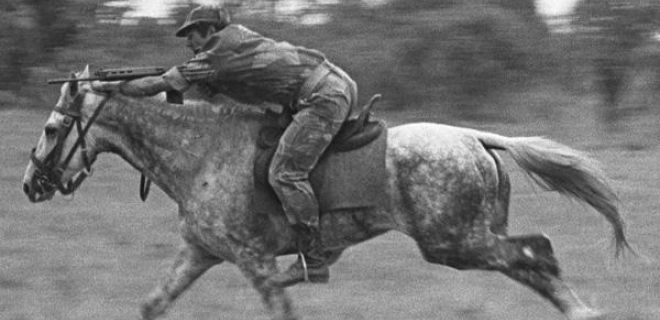 Horses and war were intertwined throughout history until the advent of the automobile. Even though the wide variety of Fighting Vehicles now carry the Cavalry into battle, horses have found their utility in 20th century Law Enforcement and War. Although the day of General George Armstrong Custer and J.E.B. Stewart engaging in major battles are pieces of history and only live through re-enactment, mounted troops survived to help today’s U.S. Border Patrol and were a unique tool in the Rhodesian Bush War. As discussed in other pieces on Rhodesia, manpower was limited and the ground to be covered became larger as the war progressed. Even though the transportation modes of the Helicopter and Land Rover were the primary mover of men, the Grey’s Scouts were used very effectively in the COIN warfare setting. Horses could move through areas that motorized vehicles could not and sped up tracking parties, running the insurgents down while keeping the Rhodesian Soldier fresh for contact. I would like to introduce Michael Watson, a member of the Grey’s Scouts during the Bush War and in the process of documenting its full history and putting it in book form. He was generous enough with his time to participate in an interview for SOFREP. The Scouts are a vital part of the ingenuity and determination to make due with what they had to meet the enemy head on at full gallop. SOFREP: Michael, please introduce yourself and your association did you have to the Bush War? MW: I am the fourth generation of a military family (both paternal and maternal sides) that go back to the Boer War. I was a reluctant conscript in 1974, having spent four years in the BSA Police after leaving school. I decided war and police life was not for me and left Rhodesia, my home and country, for the UK and a more (what I thought) peaceful existence. I was back home after wandering around Europe for 18 months, finally realising that Rhodesia was the only country I experienced that was worth defending. On my return I was immediately called up and joined the Grey’s Scouts as a volunteer territorial soldier. If you count my Police service I was connected with the Bush War in some form or another for over 10 years. With my father being a career soldier with the RAR and the Grey’s Scouts among others, you could say I was intimately involved throughout the Bush War period, from the early sixties until the war ended 1980. I was still being conscripted in 1982 when I decided to take my young family out of the country, finally realizing all was lost! 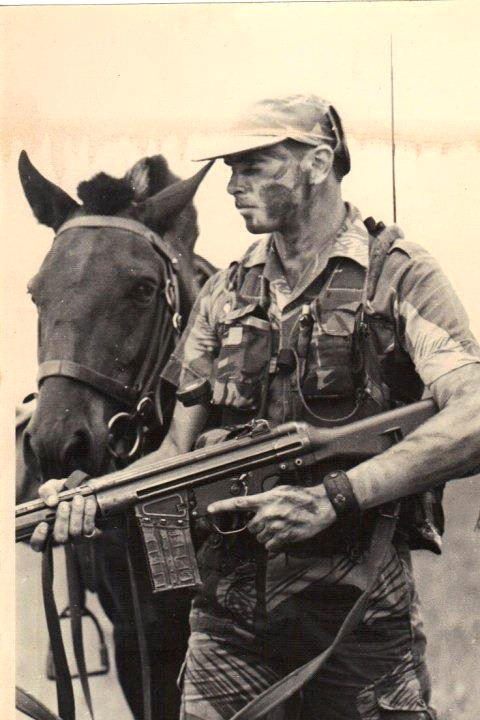 SOFREP: How and when did the Horseback Scouts appear and begin operations in the Bush War? You can give a brief lineage if you want. MW: Rhodesia, as with Britain and America, has intimate historical connections with the concept of horseback scouts going back to the 1890 Pioneer Column, when Frederick Courteney Selous was hired by Cecil John Rhodes as Head Scout for the column. In 1893 and 1896 Selous, Fred Burnham (American), Pete Ingram (American), Maurice Gifford (English/Canadian), George Grey, Vigne, Dollar, Le Roux, Collenbrander and Raaff (South African born frontiersmen) were all, by then, experienced experts that answered the desperate call for professional scouts during the Matabele Wars of those years. A superb and honorable heritage that most Rhodesians hold in awe, their feats of heroism having taken on mythical proportions. Their success in leading numerous skirmishes, putting down the rebellions that led to peace and unparalleled progress in Rhodesia for over sixty years are legendary. So much so that when the call came again in 1974, when Rhodesia’s back was once more against the wall, three regular men in the Rhodesian Defence Force got their heads together and persuaded a very skeptical Army HQ to try the concept again in the modern era. These men were Maj “Beaver” Fraser Kirk RhMT, Capt Tony Stephens RLI, and WO1 “Rum” Roy Watson RAR (my father). Based on the successes of the past, all three men were convinced it could work again, after all, it was the same bush and the same enemy, albeit sixty years on where military tactics and concepts had changed. After many trials, steep learning curves, and false starts, their tenacity paid off. Army HQ gave the go ahead for the first territorial call up of civilian horsemen who had already experienced full army initial training. Having this qualification, I volunteered on hearing the unit was being formed. After full operational trials in the relatively peaceful (at the time) Eastern Border area of the country, our first “hot” posting was in the North East Operational Area, Op Hurricane, on the Mozambique/Zambian Border based at Mukumbura. We were tasked with patrolling the border fence line from Kotwa in the east to the Musingesi River in the west entering the lower Zambesi River, not too far east of the great Kariba Dam. It was the formidable rainy season, the area was notorious for flooding and mechanical vehicles were unable to patrol this area with any success, being bogged down and altogether frustrated with the impassable terrain. The Mounted Infantry Unit, as they were known for a short time, were the only patrols that easily traversed the cutlines. There was also a Cordon Sanitaire along a good portion of the border which was inhibiting ad-lib terrorist incursions. This section had to be thoroughly observed for any breaches and follow up on any tracks discovered. This was ideal operating conditions for only one specialist unit, the horse mounted scouts. Mechanized vehicles were rendered utterly useless by the treacherous muddy conditions, and air reconnaissance was expensive, and impractical as their limited services were always in demand elsewhere for the rapidly developing “fireforce” successes. Electronic surveillance on the cordon fence also proved impractical for various, mainly technical, reasons. My book describes in detail how we managed to develop successfully into a force to be reckoned with on the Cordon Sanitaire modus operandi. Quick “fireforce”, on-the-spot reaction to breaches of the fence line, rapid follow-up on terrorist tracks became our signature performance, our lack of success with kills limited only by the areas being “frozen” by Selous Scouts operations. This as a result of the unfortunate blue on blue killing of one of our first volunteers Bruno Rabie’s brother, the famous Selous Scout Andre Rabie. 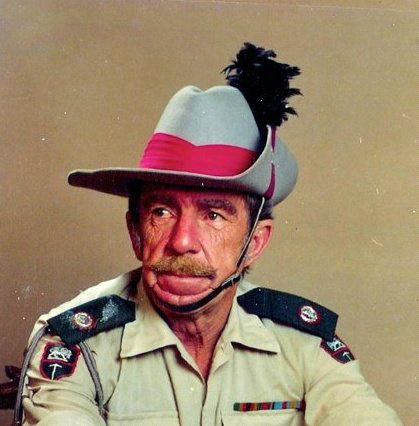 Major “Beaver” Frazer Kirk, First Officer Commanding Grey’s Scouts SOFREP: How were the troops organized and how were troops selected? MW: There was initially just a small HQ unit from volunteers within the Defense Force (both Regular and Territorial) comprising of experienced Infantry instructors and personnel (RAR, RLI, Selous Scouts and SAS), Equitation instructors (all ex-BSA Police), Veterinary and Farrier (TA members). This rugged and highly efficient establishment formed the nucleus of the unit, some of whom signed on for short service permanent contracts. The regulars operated as facilitators to the first TA call up but developed rapidly into a full-fledged regular troop, called Alfa Troop as opposed to HQ Troop. We were called Bravo Troop and alternated six weeks about for most of the rest of the war. The unit also developed a National Service Troop who were filtered into Bravo Troop for statutory call ups, or Alfa Troop if they decided to sign on permanently after initial training. Eventually, by about 1978, the three troops developed into a full regiment of three operational squadrons, Alfa, Bravo and Charlie, plus the HQ aquadron. The war ended before the Regiment could be fully and effectively utilized in the pure sense of the word. 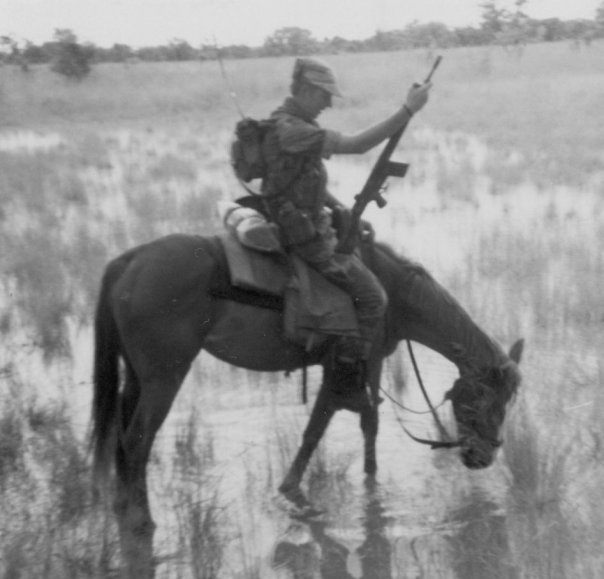 A Grey’s Scout on Horseback SOFREP: What type of missions were the Scouts tasked with? Was combat on horseback or were they just a mode of transportation? MW: Our missions were patrolling often inaccessible border fence lines, and fabricated cut lines, most all of which were constructed by Army Engineer squadrons, or occasionally Tsetse fly control units. Cross graining of suspected saturated terrorist occupied areas following obvious features, tree lines, water courses, isolated pans/wild animal watering holes and other suspected or frequented terrorist infiltration routes. Observation and location of terrorist tracks, immediate reporting and reaction to sighting of tracks or spotting the enemy, rapid deployment onto tracks when located, requesting assistance if necessary and where possible by radio communication. Combat was almost always dismounted, using the speed and height of our horses to rapidly follow enemy tracks. Our aim was only to get to engage with the enemy in the quickest possible time, invariably initiated when ambushed. There were a few exceptions to this rule which are alluded to in my book, but this was outside the official procedure. 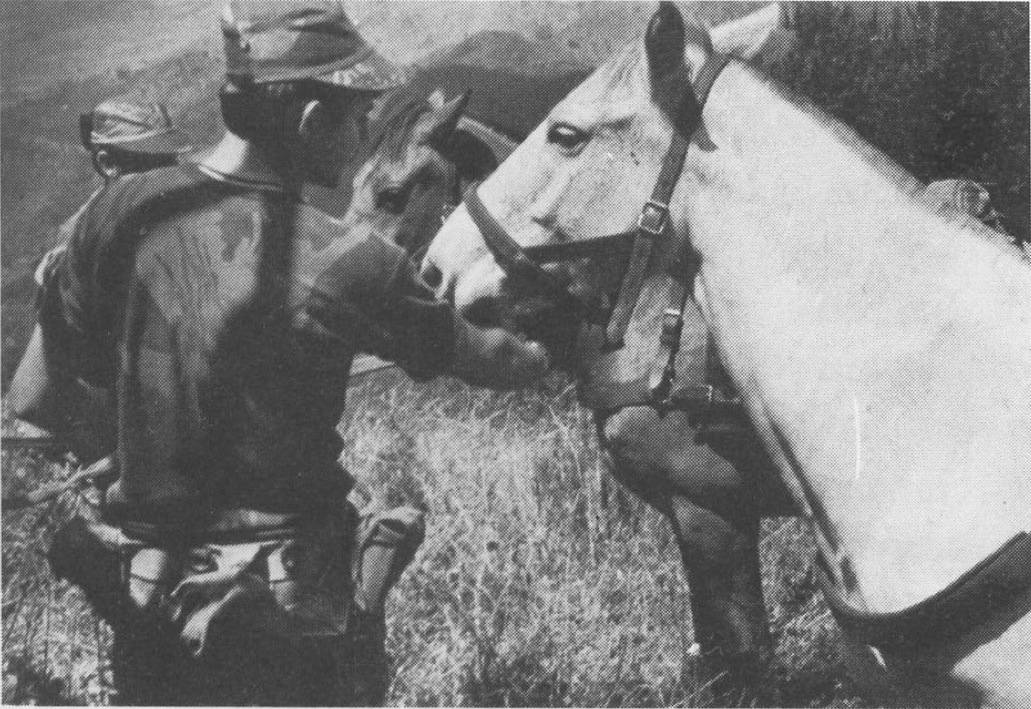 Grey’s Scouts with horses SOFREP: What nationalities was the unit composed of and was it racially integrated? MW: Initially the rapid recruitment of Territorial Army fully combat-trained volunteers, who were also horsemen, precluded many. Ranchers, farmers, policemen who had done equitation courses, professional jockeys, polo players and others who were recreational horsemen were hastily recruited. Some exceptions were African volunteers from other units who had been grooms or had ridden horses as assistants or ranch hands before joining the army. These men were unique gems few and far between, but notably at least two from warring African tribes, I know of personally, became legends. So yes, the unit was always multi-cultural and anyone meeting the requirement on merit were accepted. In our first major contact with over 100 enemy, our ten man patrol had two Africans from local Shangaan tribes within it. They were expert and experienced trackers as well as good horsemen. We had volunteers from America, Australia and New Zealand (mainly ex Vietnam vets), from Britain and France (including Foreign Legion vets), but the bulk were generational Rhodesians, some fourth or fifth generation with the same daring, brave, cunning and reckless spirit of their forefathers, named as “Men of Men, as their Fathers before them, boys who act as lions, who make us appear as women” by the famous Matabele Supreme Commander Mjaan on the 4th December in 1893 at the epic Battle of the Shangani River. 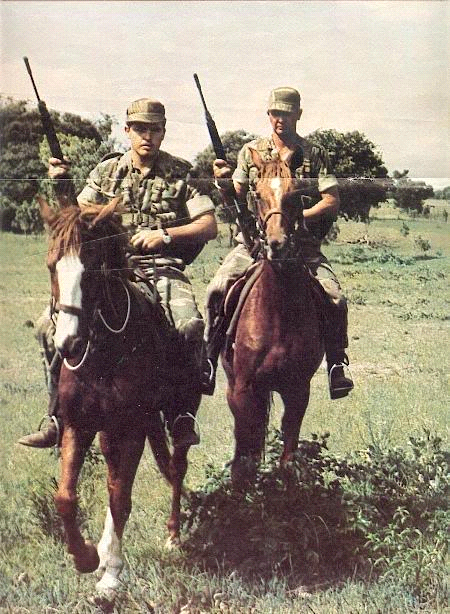 Grey’s Scouts on Patrol SOFREP: What is coming up for you as an author and historian? MW: When I have finished this current book on the Grey’s Scouts and their history from 1890-1980, I have a number of other books up my sleeve. The second one will be about my paternal and maternal family history going back four generations in the military. The book is already named “Rum Roy Watson and Company.” Collectively we have over forty medals for bravery, for various campaigns, and notable historical battles, including a DCM (Boer War), DSO, MC and Bar, First World War, and an MBE (military) Aden. Four MID’s. The campaign medals include both Boer Wars (Paardeberg, Relief of Kimberly, Belfast, Diamond Hill, Driefontein and Johannesburg), First World War, including The Somme, Second World War including the Arnhem landings, Palestine, Malaya, Aden and Rhodesia. An achievement, for which I am immensely proud. I want to continue with the affect of war on past, present and future generations, PTSD etc. I am intensely passionate about this subject and the future care and stimulation of our war veterans, especially the wounds they have received both physical and mental. Also, the history of the horse in warfare and the rescue of horses traumatized by ill treatment. I want to facilitate and promote the installation of a memorial to the Grey’s Scouts and their horses next to the Troopie Statue on Lord Salisbury’s Estate in Bedforshire UK. SOFREP: Thank you for your time and contribution to the SOFREP community! Dan Tharp Quelle: http://sofrep.com/15456/greys-scouts-inter.../#ixzz2Hkx76Ohp -------------------- "avenidas/avenidas y flores/flores/flores y mujeres/avenidas/avenidas y mujeres/avenidas y flores y mujeres y/un admirador" - Eugen Gomringer
"Two possibilities exist: either we are alone in the Universe or we are not. Both are equally terrifying." - Arthur C. Clarke Proud member of Versoffener Sauhaufen™! #natoforum |
|
|
|
 12. Jan 2013, 16:39 | Beitrag
#78 12. Jan 2013, 16:39 | Beitrag
#78
|
|
|
Oberleutnant Beiträge: 1.288 Gruppe: Members Mitglied seit: 27.01.2009 |
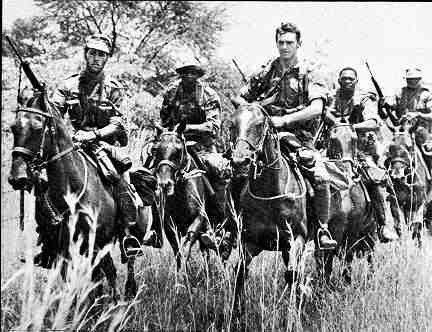 Zu dem Beitrag von Dave76 und meinem obigen Bild fällt mir spontan die Frage ein, wie verbreitet die Ausbildung an Reit- und Tragetieren bei den EGB-Kräften der Bundeswehr ist. Ist eine solche Ausbildung am Zentrum für Tragetierwesen der Bundeswehr eine fester Bestandteil der EGB-Ausbildung oder wird dies nur bei Bedarf durchgeführt? Zwar ist es für europäische bzw. nordamerikanische Schauplätze wahrscheinlich effektiver und effizienter motoristierte Fortbewegungsmittel zu nutzen um Räume zu überwachen und Truppen zu verschieben. Aber es dürfte genug Gegenden auf der Welt geben, die Konfliktpotential in sich bergen, wo es nicht falsch wäre Pferde als Transportmittel zu nutzen. Zumal Pferde und Esel in den betroffenen Regionen oft häufig anzutreffen sind und Kraftfahrzeuge in manche Geländeabschnitte nicht vorstoßen können.  Reiter des Bundesheeres bei der Grenzüberwachung 1 Reiter des Bundesheeres bei der Grenzüberwachung 2 -------------------- ZITAT Aufpassen, dass man nicht mit der Arroganz des eigenen Weltbildes andere aburteilt Goschi Je fester man davon überzeugt ist, im Recht zu sein, desto natürlicher ist der Wunsch, jeden anderen mit allen Mitteln dahin zu bringen, ebenso zu denken. - George Orwell |
|
|
|
 1. May 2022, 17:15 | Beitrag
#79 1. May 2022, 17:15 | Beitrag
#79
|
|
|
Hauptmann Beiträge: 2.983 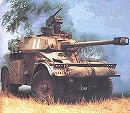 Gruppe: VIP Mitglied seit: 15.08.2005 |
Ich schände gerne Leichen:
 ZITAT Polish soldiers from the Territorial Defense Forces on horseback during a patrol of the Polish-Belarusian border. The crisis at the border has shown that horses are in many cases better for patrolling when it is necessary to cross a river or other terrain inaccessible for vehicles. Artikel zum Thema: https://www.gov.pl/web/border/horse-patrols...border-security |
|
|
|
 1. May 2022, 19:20 | Beitrag
#80 1. May 2022, 19:20 | Beitrag
#80
|
|
|
Hauptmann Beiträge: 2.542  Gruppe: Members Mitglied seit: 17.07.2012 |
Ich schände gerne Leichen:... Artikel zum Thema: https://www.gov.pl/web/border/horse-patrols...border-security Verstehe nur ich nicht, was die Leichen-Aussage mit dem Beitrag zu tun hat? |
|
|
|
 1. May 2022, 19:22 | Beitrag
#81 1. May 2022, 19:22 | Beitrag
#81
|
|
|
Herr der Dunkelheit Beiträge: 36.435  Gruppe: Admin.WHQ Mitglied seit: 21.04.2002 |
der Thread war davor 9 Jahre unbenutzt, im WHQ nannten wir das immer gerne mal Nekromantie, wenn jemand derart altes hervorkramte
-------------------- Wer zum Denken nachdenkseiten braucht, denkt auch, dass ihm ihm die Tankkarte das tanken abnimmt.
Qui tacet, consentire videtur Dass die Russen viele Verluste haben aufgrund ihrer offensiven Vorgehensweise, die sie sich bei Zapp Brannigan abgeschaut haben, ist davon unbenommen. |
|
|
|
 1. May 2022, 20:31 | Beitrag
#82 1. May 2022, 20:31 | Beitrag
#82
|
|
|
Hauptmann Beiträge: 2.542  Gruppe: Members Mitglied seit: 17.07.2012 |
|
|
|
|
 26. Jul 2023, 17:16 | Beitrag
#83 26. Jul 2023, 17:16 | Beitrag
#83
|
|
|
Leutnant Beiträge: 907 Gruppe: Members Mitglied seit: 28.02.2015 |
Die Briten haben sich mit einem ursprünglichen Kavallerieregiment zu denPOlen gesellt.
https://twitter.com/BG_Poland_eFP/status/16...e-92423974.html |
|
|
|
 26. Jul 2023, 20:13 | Beitrag
#84 26. Jul 2023, 20:13 | Beitrag
#84
|
|
|
Hauptmann Beiträge: 2.983  Gruppe: VIP Mitglied seit: 15.08.2005 |
Bei der erwähnten 2. Brigade handelt es sich übrigens um eine Brigade der polnischen Territorialverteidigungskräfte, die in der Wowoidschaft Lublin stationiert ist und an der polnisch-belarussischen Grenze regelmäßig berittene Patrouillen einsetzt (zumindest gab es wiederholt Fotos davon).
|
|
|
|
  |
1 Besucher lesen dieses Thema (Gäste: 1 | Anonyme Besucher: 0)
0 Mitglieder:
| Vereinfachte Darstellung | Aktuelles Datum: 23. April 2024 - 09:51 |


















